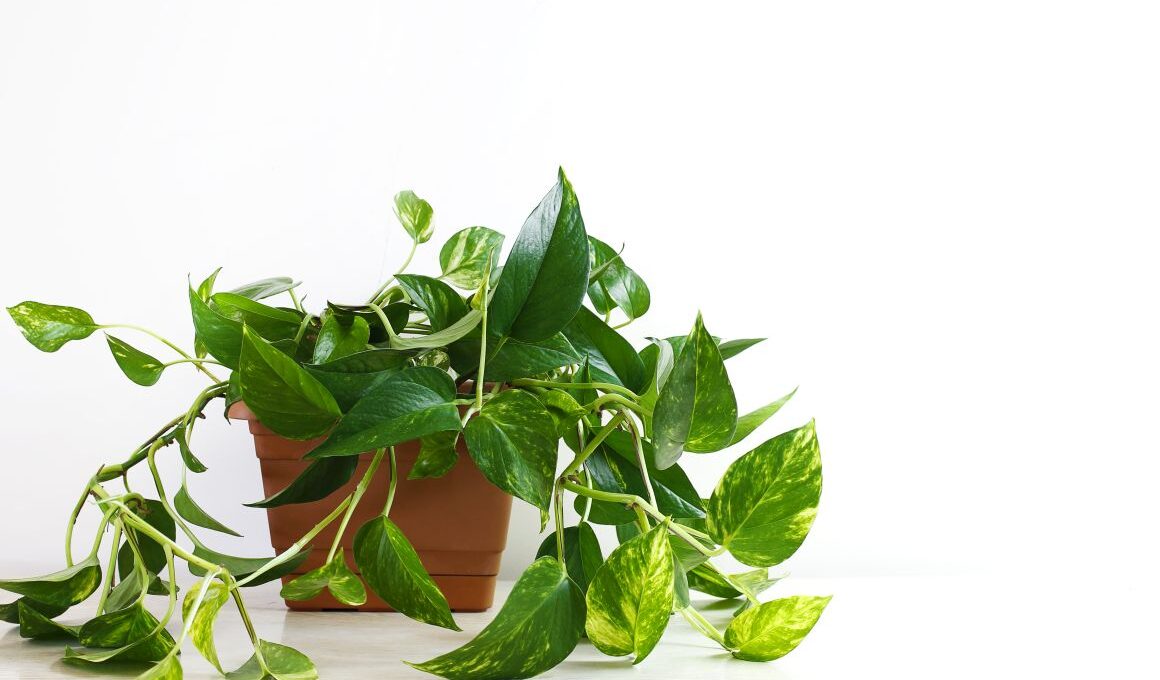What Is a Pothos Plant? Names, Origin, and Characteristics
Before we break down all aspects of pothos plant care, let’s introduce the plant. The pothos (Epipremnum aureum) is a type of vine that is native to the Society Islands. It’s also known by the names:
- devil’s ivy;
- golden pothos;
- hunter’s rove.
The pothos is an evergreen plant. Its heart-shaped leaves are variegated with yellow, white, or green. The vine can grow up to 20 feet in length and prefers to climb on trees or other vertical surfaces.
Pothos plants became popular houseplants because they’re easy to care for and can thrive in low-light conditions. In addition, the plant is believed to have positive effects on air quality, making it an ideal choice for homes and offices.
Pothos Plant Care – Soil and Fertilization
While pothos plants aren’t particularly picky when it comes to soil, they do best in a well-draining potting mix with a pH of 6 to 6.5. Make sure the pot has proper drainage holes.
As far as fertilization goes, pothos plants benefit from monthly feedings during the growing season. A balanced liquid fertilizer will do the trick, but be sure to dilute it to half strength before applying it to your plant. Overfertilizing can lead to foliage burn, so it’s better to err on the side of caution.
Pothos Plant Care – Watering Requirements
Pothos plant care is easy in part because these plants are very forgiving when it comes to watering. They prefer to have their soil moistened regularly, but they’ll tolerate occasional periods of drought.
When watering your pothos, be sure to check the soil first. If the top inch or so is dry, it’s time to water. Allow the water to seep slowly into the soil, until it begins to drain out of the bottom of the pot. Be careful not to over-water, as this can lead to root rot.
Pothos Plant Care – Light Conditions
These indoor plants are tolerant of different light conditions. While they will thrive in bright, indirect light, they can also tolerate low light levels. However, they may lose the variegation in their leaves if they don’t get enough light. It’s also important to avoid placing them in direct sunlight, as this can scorch the leaves. With a bit of trial and error, you should be able to find a spot that is just right for your pothos plant.
Pothos Plant Care – Temperature and Humidity Requirements
Pothos plants are native to the tropical jungles of Oceania, so they’re used to warm temperatures and high humidity. Indoors, they like to be in rooms that are at least 70 °F, and they prefer humid environments where the air is filled with moisture.
If you live in a dry climate, your pothos plant care routine might have to include misting them every day. Or, you could set the plants on top of a pebble tray filled with water. As long as you provide proper temperature and humidity, your pothos should thrive.
Do You Need to Prune Pothos Plants?
Pruning doesn’t have to be part of your pothos plant care routine. In fact, it’s only necessary if you want to control the plant’s growth or shape it in a particular way.
If left unpruned, pothos plants will typically grow quite long and trailing. To encourage compact growth, simply cut back the stems by a few inches every couple of months. You can also prune away any damaged or yellowed leaves as needed.
How to Propagate Pothos Plants?
Propagating a pothos plant is a simple process that just about anyone can do. All you need is a healthy pothos plant, a sharp knife, and a glass of water.
- Start by choosing a healthy-looking stem, making sure to include 4-6 inches of length and at least two green leaves.
- Make the cut just above a root node (the spot from which aerial roots grow).
- Place the cut stem in the glass of water or a small pot of potting soil and set it in a sunny spot. Within a few days, you should see roots beginning to form.
How Often Should You Repot Pothos Plants?
Pothos plants are not particularly fussy when it comes to their pots. With that said, they do benefit from being repotted every one or two years. This gives them fresh potting mix and room to continue growing.
Common Problems with Pothos Plants
Even these tough plants can occasionally experience problems. One of the most common issues is root rot, caused by too much water or poor drainage. Overwatered pothos plants may develop yellow leaves and stunted growth.
Mealybugs and spider mites are two common pests that can infest pothos plants. Mealybugs are small, white insects that feed on plant sap. Spider mites are tiny arachnids that spin webs on the undersides of leaves. Both of these pests can cause a pothos plant to become yellow and wilted.
Pothos Plant Toxicity
Pothos plants are considered to be mildly toxic to both humans and animals. It won’t cause any severe symptoms if ingested in small quantities. However, they can cause stomach upset because they contain calcium oxalate. The sap from the leaves can also cause irritation if it comes into contact with your skin.
As a general rule of thumb, it’s best to keep pothos plants out of reach of small children and pets. If you have any concerns, it’s always best to consult with a medical professional.
Prepared to Care for a Pothos Plant?
Pothos plants are one of the most popular houseplants for good reason – they’re easy to care for and can tolerate a wide range of growing conditions. With a bit of basic pothos plant care, you can keep your plants healthy and happy for years to come.
Have you ever had a pothos plant? Share your tips and advice in the comments below!



















